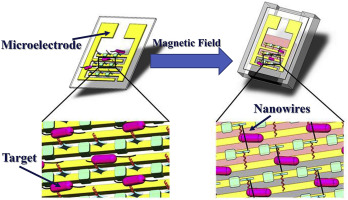Our official English website, www.x-mol.net, welcomes your
feedback! (Note: you will need to create a separate account there.)
Rapid and sensitive detection of Salmonella Typhimurium using nickel nanowire bridge for electrochemical impedance amplification.
Talanta ( IF 5.6 ) Pub Date : 2020-01-07 , DOI: 10.1016/j.talanta.2020.120715 Lei Wang 1 , Xiaoting Huo 1 , Wuzhen Qi 1 , Zengzilu Xia 2 , Yuntao Li 3 , Jianhan Lin 1
Talanta ( IF 5.6 ) Pub Date : 2020-01-07 , DOI: 10.1016/j.talanta.2020.120715 Lei Wang 1 , Xiaoting Huo 1 , Wuzhen Qi 1 , Zengzilu Xia 2 , Yuntao Li 3 , Jianhan Lin 1
Affiliation

|
Rapid detection of foodborne pathogens is crucial to prevent the outbreaks of foodborne illnesses. In this study, a sensitive electrochemical aptasensor was developed using aptamer coated gold interdigitated microelectrode for target capture and impedance measurement, and antibody modified nickel nanowires (NiNWs) for target separation and impedance amplification. First, the interdigitated microelectrode was modified with the biotinylated aptamers against Salmonella typhimurium through electrostatic absorption of streptavidin onto the microelectrode and streptavidin-biotin binding. Then, the target Salmonella cells were magnetically separated and concentrated using the NiNWs modified with the anti-Salmonella typhimurium antibodies to form the bacteria-NiNW complexes, and incubated on the microelectrode to form the aptamer-bacteria-NiNW complexes. After an external arc magnetic field was developed and applied to control the NiNWs to form conductive NiNW bridges across the microelectrode, the enhanced impedance change of the microelectrode was measured and used to determine the amount of target bacteria. This electrochemical aptasensor was able to quantitatively detect Salmonella ranging from 102 to 106 CFU/mL in 2 h with the detection limit of 80 CFU/mL. The mean recovery for the spiked chicken samples was 103.2%.
中文翻译:

使用镍纳米线电桥快速灵敏地检测鼠伤寒沙门氏菌,用于电化学阻抗放大。
食源性病原体的快速检测对于预防食源性疾病的爆发至关重要。在这项研究中,开发了一种灵敏的电化学适体传感器,该传感器使用适体包被的金指状微电极进行靶捕获和阻抗测量,并使用抗体修饰的镍纳米线(NiNWs)进行靶分离和阻抗放大。首先,通过链霉亲和素在微电极上的静电吸收和链霉亲和素-生物素的结合,用抗鼠伤寒沙门氏菌的生物素化适体修饰叉指状微电极。然后,使用抗鼠伤寒沙门氏菌抗体修饰的NiNWs磁性分离并浓缩目标沙门氏菌细胞,形成细菌-NiNW复合物,并在微电极上孵育以形成适体-细菌-NiNW复合物。在开发了外部电弧磁场并将其应用于控制NiNW形成跨微电极的导电NiNW桥之后,测量微电极增强的阻抗变化,并将其用于确定目标细菌的数量。该电化学适体传感器能够在2 h内定量检测沙门氏菌(Salmonella),范围为102至106 CFU / mL,检测极限为80 CFU / mL。加标鸡肉样品的平均回收率为103.2%。该电化学适体传感器能够在2 h内定量检测沙门氏菌(Salmonella),范围为102至106 CFU / mL,检测极限为80 CFU / mL。加标鸡肉样品的平均回收率为103.2%。该电化学适体传感器能够在2 h内定量检测沙门氏菌(Salmonella),范围为102至106 CFU / mL,检测极限为80 CFU / mL。加标鸡肉样品的平均回收率为103.2%。
更新日期:2020-01-07
中文翻译:

使用镍纳米线电桥快速灵敏地检测鼠伤寒沙门氏菌,用于电化学阻抗放大。
食源性病原体的快速检测对于预防食源性疾病的爆发至关重要。在这项研究中,开发了一种灵敏的电化学适体传感器,该传感器使用适体包被的金指状微电极进行靶捕获和阻抗测量,并使用抗体修饰的镍纳米线(NiNWs)进行靶分离和阻抗放大。首先,通过链霉亲和素在微电极上的静电吸收和链霉亲和素-生物素的结合,用抗鼠伤寒沙门氏菌的生物素化适体修饰叉指状微电极。然后,使用抗鼠伤寒沙门氏菌抗体修饰的NiNWs磁性分离并浓缩目标沙门氏菌细胞,形成细菌-NiNW复合物,并在微电极上孵育以形成适体-细菌-NiNW复合物。在开发了外部电弧磁场并将其应用于控制NiNW形成跨微电极的导电NiNW桥之后,测量微电极增强的阻抗变化,并将其用于确定目标细菌的数量。该电化学适体传感器能够在2 h内定量检测沙门氏菌(Salmonella),范围为102至106 CFU / mL,检测极限为80 CFU / mL。加标鸡肉样品的平均回收率为103.2%。该电化学适体传感器能够在2 h内定量检测沙门氏菌(Salmonella),范围为102至106 CFU / mL,检测极限为80 CFU / mL。加标鸡肉样品的平均回收率为103.2%。该电化学适体传感器能够在2 h内定量检测沙门氏菌(Salmonella),范围为102至106 CFU / mL,检测极限为80 CFU / mL。加标鸡肉样品的平均回收率为103.2%。











































 京公网安备 11010802027423号
京公网安备 11010802027423号